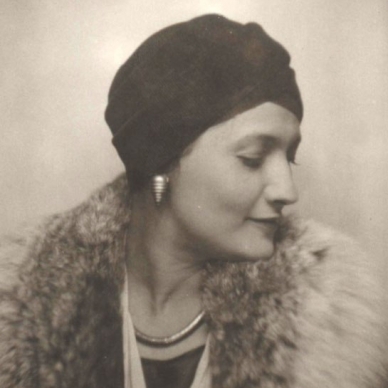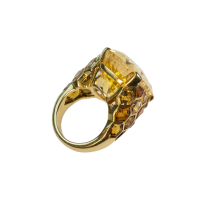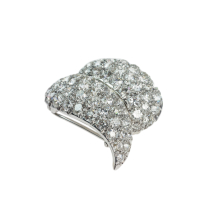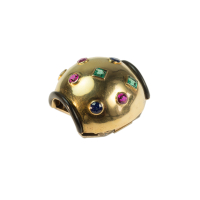Belperron Suzanne

Belperron, Suzanne (1900 – 1983)
Inventive, pioneering, bold, original, avant-garde – all describe the extraordinary work of Suzanne
Belperron, the most sought-after French Art Déco goldsmith of the 20th century.
Suzanne Vuillerme is born on 26 September 1900 in Saint-Claude in the Jura region of eastern France. In 1924 she marries Jean Belperron, and uses that name for the rest of her life. After studying at the École des Beaux Arts in Paris, Suzanne joins the Maison René Boivin as a jewellery designer in 1919, working under the mentorship of Jeanne Boivin.
Belperron leaves Boivin in 1932, following Jeanne’s steadfast refusal to allow Suzanne to create pieces under her own name. Bernard Herz – Boivin’s pearl supplier – employs Belperron and allows her to create her pieces under the name of Maison Hertz, until she also starts using her own name in 1935. She travels to Africa, Oceania, the Near and Far East, among other countries, to study different methods of processing gold, and to India to buy rubies and Sapphires for her designs.
As well as frequently using natural pearls in her designs, Belperron likes to use semi-precious and precious materials together in matching tones, for example rock crystal and diamond. She frequently uses rock crystal in her earlier geometric Art Deco designs. Belperron perfects the ‘honeycomb’ setting, where stones are supported by a hexagonal web of fine gold wires.
When the Second World War breaks out in 1939, numerous American jewellery houses, such as Tiffany & Co., offered Belperron work in the US. She turns them all down to stay in Europe with her husband and her company.
When Bernard Herz, meanwhile a dear friend of hers, is sent to a concentration camp, Suzanne registers the company in her own name only, to prevent it being taken by the state.
In 1946, Jean Herz, Bernard’s son returns from war captivity, they re-establish the company under the name Jean Herz-Suzanne Belperron SARL.
Among her many illustrious clients are the Duchess of Windsor, Mrs Salomon Guggenheim as well as Frank Sinatra. Elsa Schiapparelli wears Belperron jewellery in an issue of Vogue in 1933. Her designs are extraordinary, bold and sensual, of various materials and big stones, and are concerted on each wearer, such that she insists that even her most famous clients personally apply at her workshop.
As a follower of a new women’s image (member of the suffragettes) she self confidently and determinedly pursues her calling. She is an icon of the Parisian jewellery scene and insist on her motto: “Mon style est ma signature” and never signs her pieces. However, some can be identified by the hallmark of “Darde et Groene”, as they manufacture her designs for a certain time.
It takes a skilled eye to identify Belperron’s work and hardly any archive material exists as she burned a lot of her personal papers before her passing. A few designs reappeared recently, however.
Belperron retires in 1974, but continues to act as a consultant until her death in 1983. In 1998 the company is purchased by Ward Landrigan, CEO of Verdura.
Belperron, Suzanne 1900 – 1983
Erfinderisch, bahnbrechend, kühn, originell, avantgardistisch – so wird das außergewöhnliche Werk von Suzanne Belperron beschrieben, der gefragtesten französischen Art-Déco Goldschmiedin des 20. Jahrhunderts.
Suzanne Marie Claire Vuillerme absolviert die städtische Kunstschule in Besançon und gewinnt für ihre Abschlussarbeit den ersten Preis. An der École des Beaux Arts in Paris studiert sie Zeichnen. 1921 erhält sie ihre erste feste Anstellung im Maison René Boivin als Entwerferin. 1924 heiratet sie Jean Belperron und zieht ins Künstlerviertel Montmarte. In den Nachkriegsjahren, den goldenen Zwanzigern, erlebt Paris eine besonders schöpferische wie ästhetische Periode in allen Kunstformen, in der Mode, Musik, Tanz oder Literatur. In dieser Atmosphäre entwickelt Belperron ihren unverwechselbaren Stil, in dem sie den Zeitgeist einfängt und zeigt, welchen Schmucktyp moderne Frauen tragen wollen. 1932 verlässt Belperron das Haus Boivin und arbeitet als künstlerische Direktorin mit eigener Kollektion für den Edelstein-und Perlenhändler Bernard Herz. Während des Zweiten Weltkriegs bleibt Belperron, trotz diverser Angebote aus den USA, unter anderem von Tiffany & Co, in Paris, unterstützt Herz und übernimmt schließlich dessen von den Nazis liquidiertes Unternehmen. Als 1946 Jean Herz, Bernards Sohn, aus der Kriegsgefangenschaft nach Paris zurückkehrt, wird die Firma unter dem Namen Jean Herz-Suzanne Belperron SARL weitergeführt.
Neben Naturperlen verwendet Belperron hochwertige wie auch weniger wertvolle Materialien in einem Stück, etwa im Farbton passende Bergkristalle und Diamanten. Bergkristall findet sich besonders oft in ihren frühen geometrischen Art Déco Designs. Die „Bienenwaben“-Fassung, in dem Edelsteine in einem hexagonalen Netz von feinen Golddrähten gehalten werden, wird von Belperron perfektioniert. Sie ist eine Ikone der Pariser Juwelenbranche. Ihr Leitspruch „ Mon style est ma signature“ erklärt, weshalb sie ihre Arbeiten nie signiert. Sie entwirft Schmuck für die berühmtesten, einflussreichsten Persönlichkeiten ihrer Zeit, darunter etwa der Herzog und die Herzogin von Windsor, Elsa Schiapparelli, die Rothschilds und Guggenheims wie auch Frank Sinatra.
1963 verleiht Frankreich ihr den Orden der Legion d’honneur. Nach über 50 Jahren voller Leidenschaft für Juwelen und Design geht Belperron 1974 in den Ruhestand. Sie stirbt 1983. In ihrer Hinterlassenschaft findet sich ein umfangreiches Archiv, mit dessen Hilfe eine Katalogisierung ihres Oeuvres erst möglich wird. 1998 übernimmt Ward Landrigan, CEO von Verdura, „Belperron“.


